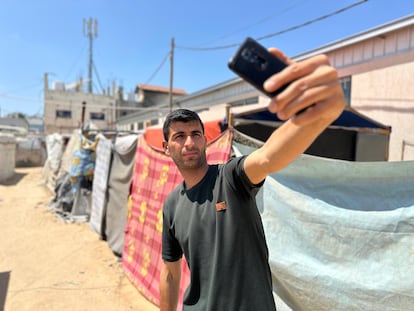‘Hi, I’m Ahmed, from Gaza’: Diary of hunger, displacement and fear
Five days in five videos that chronicle daily life in the Gaza Strip. A cameraman captures the suffering of the people in this Palestinian territory, bombarded and devastated by the Israeli army

How do you cook, charge a cell phone, go to the bathroom, or get to sleep when you’ve lost everything and are living in a displacement camp? Ahmed Abu Kmail, a 38-year-old Palestinian cameraman, is our source of information in this diary from Gaza, where the simplest acts of daily life have become an unimaginable obstacle course.
Since the outbreak of war in October 2023 — during which Israel has killed over 54,000 Palestinians, according to Gaza’s Ministry of Health data, used as a reference by the U.N.— Abu Kmail has been forced to relocate six times with his wife and four children. He is currently surviving in a precarious tent in the center of the Gaza Strip that no longer protects them from either the cold or the heat. His house has been bombed, and he knows that even if there is a ceasefire tomorrow, he will not be able to return. “Nothing in Gaza resembles a normal life,” he repeats at various points in this diary.
1. Hunger
The more than two million inhabitants of Gaza are going hungry, and half a million are expected to be in a dire situation by September if Israel does not allow essential humanitarian aid to enter, according to the latest U.N. data. For Ahmed Abu Kmail, the image of hunger is an old, empty pot. The one held in the hands of the hundreds of people who have been lining up since dawn at the Nuseirat refugee camp, in the center of Gaza, where lentil soup is being distributed. If they are lucky, it will likely be their only meal of the day, but some will leave empty-handed.
“Hunger is a slow death,” says Abu Kmail.
2. Displacement
At least 90% of Gazans have been displaced at least once since October 2023, and 92% of homes have been totally or partially destroyed in the war. Ahmed Abu Kmail has changed shelters six times. Each flight is more painful and complicated than the last: the tent is more tattered, it’s harder to transport their few belongings, and it’s difficult to find a place to sleep, as the majority of the population is concentrated in the center of the Gaza Strip. Above all, they are more tired and demoralized. In this video, Abu Kmail shows us where his children sleep, the area they have converted into a bathroom, and the damaged solar panel where they try to charge their phones. These are the miserable living conditions they have been forced to adapt to overnight. “But despite everything, we haven’t lost hope,” he says.
3. Education
The children of Gaza have not been in school since October 7, 2023, when the war began, and even if there were a ceasefire tomorrow, it will take a long time for them to return. According to the U.N., 90% of schools need to be rebuilt or rehabilitated. But education is finding a way to continue amid the devastation and ruins. Ahmed Abu Kmail takes us to a tent where Hana Abu Rizq, a volunteer teacher, gathers a group of children every day to teach them reading, writing, and addition. We are in a squalid displacement camp, and the tent is stiflingly hot; the children sit on the floor and have barely any notebooks or pencils. “But the idea is to ensure they don’t lose the habit of learning,” the teacher insists.
4. Water
Gaza is on the Mediterranean coast, but drinking water is scarce and has become another weapon in the war. Ahmed Abu Kmail shows us a distribution point at a small desalination plant that is still operating in the center of Gaza. According to the U.N., 89% of Gaza’s pipes, drains, and desalination plants have been completely or partially destroyed, and 90% of families have suffered and continue to suffer from the lack of safe drinking water. People waiting in line do not have to pay to fill their containers, but they do have to wait for several hours.
“The war has taken many things from us, including water,” says Abu Kmail. The WHO recommends a minimum of 15 liters of water per person per day to meet basic needs, but in Gaza right now, they only have around five liters.
5. Fear
The buzzing of Israeli drones in the sky. Day and night. Every day. Gazans have been living like this since October 2023. It’s the sound of fear. Fear also comes from the explosions and bombs that can strike at any time and anywhere. “And suddenly, we’re just numbers,” says Ahmed Abu Kmail, filming children playing soccer on a street in Deir al-Balah, in the center of the Gaza Strip. And when night falls, there is even more anxiety, especially for the children. “I want the drones to go away and the war to end,” says Amir, one of the cameraman’s sons, by the light of the bonfire the family uses to chase away their fears.
Sign up for our weekly newsletter to get more English-language news coverage from EL PAÍS USA Edition






